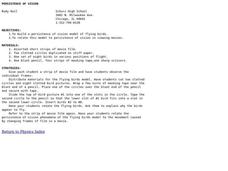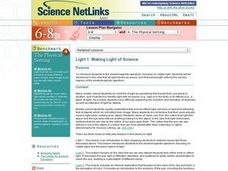Exploratorium
Persistence of Vision
Ahoy, matey! Peer through a special telescope to explore the persistence of vision. The telescope has only a thin strip with which to view the world, but as it scans the area, your eye and brain work together to create a complete...
Curated OER
PERSISTENCE OF VISION
Eighth graders explore how vision effects viewing. In this vision instructional activity students build a persistence of vision model of flying birds.
Curated OER
Magic Wand
Pupils observe how an image falling on a CCD array is divided into individual pieces, by the property of persistance of vision.
Curated OER
Rainbow Spinner
In this rainbow spinner activity, students participate in making a rainbow spinner in order to investigate the splitting and mixing of light. Students study the theory of persistence of vision.
Curated OER
Persistence of Vision Tube
Students demonstrate how individual pieces of data combine to produce complete images.
Curated OER
The Science of Color and Light
Learners listen to a story about colors and then conduct various experiments to determine how people see colors, identify which colors stand out best from a distance, show the results of mixed colored lighting and explain the phenomenon...
Curated OER
John Muir's Vision Lives On
Students identify perspectives on land management issues. They research and debate Yosemite's General Management Plan and develop personal responsibility on a local issue through citizen action.
Curated OER
All Those Seeing Color, Say Eye!
Students research and discuss the roles of the eye and brain in the perception of color. They watch a slideshow and complete a worksheet.
Curated OER
Science
Third graders study light and shadow, participate in mirror activities, and build a periscope.
Curated OER
Spinners of Color
Students review primary, secondary, and intermediate colors. They use a worksheet to select the combination of colors they want to try on the spinners. They predict the outcome of the spinning colors.
Howard Hughes Medical Institute
The Making of the Fittest: Got Lactase? The Co-evolution of Genes and Culture
Got milk? Only two cultures have had it long enough to develop the tolerance of lactose as an adult. Learn how the responsible genes evolved along with the cultures that have been consuming milk. This rich film is supplied with a few...
Curated OER
Simple Machines: The Wede & Lever
Students describe how wedge and lever makes work easier. In this physics lesson, students analyze experimental data by creating a graph to see the trends. They calculate the work done and mechanical advantage of these simple machines.
Curated OER
Light 3: All Those Seeing Color, Say Eye!
Students explore the nature of light. They use on-line articles and a worksheet to explore the roles of the eye and brain in the perception of color. They draw and label a diagram illustrating the movement of light.
Curated OER
Chemical and Physical Changes
Eighth graders investigate different gas behaviors. In this chemistry lesson, 8th graders describe how changing volume and temperature affect gas particles motion. They collect data and make a generalization about these variables'...
Curated OER
The Lighter Side of Color
Students explore light and color, including how colors are mixed to produce new colors, how light is filtered, and how light is reflected off of surfaces. They read materials provided, complete worksheets, and complete hands-on activities.
Curated OER
Light 2: The Lighter Side of Color
Middle schoolers explore light and color, including how colors are mixed to produce new colors, how light is filtered, and how light is reflected off of surfaces.
Curated OER
Making Light of Science
Students investigate the electromagnetic spectrum, focusing on visible light. They are introduced to the idea that all light travels as waves, and that wavelength defines the various regions of the electromagnetic spectrum.
Curated OER
Water and Ice
Pupils explore water. In this water lesson, students explore the physical properties and states of water. They observe how water changes states and document what they see.
University of Colorado
University of Colorado: Physics 2000: The Big Picture
Ever wondered how your TV produces those images on the screen? You can use the explanations and the interactive applets on these pages to find out how a cathode ray tube allows you to watch your favorite show!


















